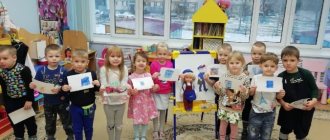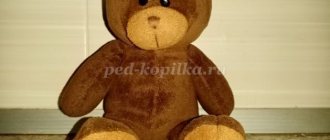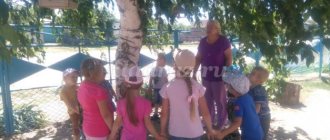Middle group. Junior preschool age. Children 4 - 5 years old
Excursion “Through the streets of the beloved village of Pervomaisky” in the middle group Excursion “Through the streets of the beloved village of Pervomaisky”
in the middle group Goal: to expand children’s ideas about their native village of Pervomaisky. Objectives: To develop in children a cognitive interest and love for their native village, concern for its cleanliness and beauty; Expand children's knowledge about...
Summary of the excursion to the library “Library - House of Books” for children of the middle group
Summary of an excursion to the library for middle group children. "Introduction to the Library"
Goal: to continue to acquaint children with the social objects of the village and their purpose. Objectives: 1. Expand children’s understanding of the professions of social workers, the content and significance of their work...
Excursion to the spring park
— At home you should have picked up sayings about spring.
Winter scares spring, but it itself melts.
In the spring it bakes on top and freezes below.
Spring is red and hungry.
If you miss a day in the spring, you won’t get it back in a year
.
4.Collection of natural materials.
Collection of branches, fruits of deciduous trees and shrubs, cones of coniferous trees. Students collect natural materials. Once again we admire the variety of spring colors and feel like a part of the surrounding nature.
5. Game – competition “Recognize the tree by description”
— And now we’ll hold a game-competition “Recognize a tree by description” (
The teacher reads a description of the trees)
1. The Russian people fell in love with the white-trunked beauty. How many songs and poems have been written about her. This is one of the most beautiful trees in Russia. Its white trunk remains cold even on hot days. This tree produces up to 40 liters of sap before buds open. Furniture and plywood are made from it. The bark of this tree, birch bark, is ready-made natural paper. (Birch)
2. This tree is familiar to all of us since childhood. Not a single New Year's holiday is complete without it. It is green all year round, because... its needle leaf lives for 2-3 years, and the needles do not fall off all at once, but gradually, throughout the year. Birds love her. And the bear often builds its den under this tree. She lives up to 1200 years. (Spruce)
3. This tree grows not only in forests, but also in parks and gardens. It is often planted along the fences of houses so that it will delight people with its white lush inflorescences in the spring and fiery tassels in the fall. She lives up to 150 years. In early autumn, its berries are bitter-sour and hard. But as soon as the first frost catches them, they become tastier and softer. Jams and jams are made from the berries of this tree, and the honey from this tree is fragrant and healthy. (Rowan)
4. This tall, slender tree with a greenish-gray smooth trunk and a thick green crown decorates the squares and streets, squares and parks of our city. It perfectly cleans the air of dust and soot and releases more oxygen into the atmosphere than other trees. In spring, large buds swell on this tree. When the sticky shell falls from them to the ground, fragrant, shiny green leaves open. At the end of May, seed pods ripen on the tree. They burst and the fluff, caught by the wind, flies along the streets, as if covering the ground and trees with snow. (Poplar)
5. This tree is not picky about soil and can grow on sandy soils. It is photophilous. In the forest of these trees you can breathe easily. Wood grouse eat the needles of this tree; residential buildings are built from its logs, bridges and outbuildings are erected. The resin of this tree, which is collected by cutting the bark, is also valued. The juice of the pine needles and the infusion of the buds of this plant treat coughs and colds. Pine baths calm a person and strengthen his body. Amber was born from the resin of ancient representatives of this tree. (Pine)
Excursion in the fall in the middle group “Autumn changes in nature”
Summary of the autumn excursion in kindergarten in the middle group “Autumn changes in nature”
Age category of children: 4-5 years Goals and objectives: - observation of autumn changes in nature - develop observation, logical thinking, ability to compare - promote the development of cognitive interest - educate love and respect for nature
Excursion progress:
— Guys, what time of year is it now?
(Autumn) - Listen to a poem about autumn: Autumn has come, Our garden has turned yellow.
The leaves on the birch tree are burning golden. Do not hear the cheerful Songs of the nightingale. The birds flew away to distant lands. — What signs of autumn are listed there? (the leaves turned yellow, migratory birds flew away) - What other signs of autumn do you know? (It’s cold, it rains often, leaves fall from the trees) - Correct. Look at the sky, how gloomy it has become, how few leaves are left on the trees:
— Now we will take a walk around the area around the kindergarten and observe how nature has changed with the onset of autumn. - Here is our flowerbed. Do you remember how beautiful the flowers were here in the summer? There were a lot of flowers, we watered them and loosened them. Look what happened to them now? (They dried up, turned black, withered).
- Why do you think this happened? (They feel bad, it’s cold, there’s not enough sun) - Look, this is Rudbeckia, it froze when the snow fell:
- Now let's see what has changed in the garden? (The harvest was harvested, almost nothing remained in the beds, only weeds and fallen leaves). - Look, what kind of vegetable did I find in the garden? (carrot)
— Guys, look, how have the trees and shrubs changed? (The leaves have turned yellow, the leaves are falling, some are already without leaves)
“Are we really not going to see a single flower again?” There are flowers that are not as afraid of the cold as others. Look, there are still flowers left on Hydrangea:
- Now look here. What kind of tree is this? (Rowan) That's right, come closer, we'll take a look at it. What do we see on the branches of rowan? (Berries). - Who will be happy with these berries? (Birds) - That's right, the birds that stay with us for the winter.
“Can’t we find a single green tree with you?” (Let's find that the Christmas trees remain green) - That's right, almost all coniferous plants remain green. Let's take a closer look at the spruce. What are the needles on spruce trees called? (Needles) What can you say about spruce needles? (green, prickly, does not fall off in the winter)
Did you guys like our tour? (Yes) We will walk here again when the next season comes to observe how nature changes. What time of year will be after autumn? (Winter)
We recommend watching:
Summary of educational activities in the middle group with the use of ICT on the topic “Autumn” Summary of a speech therapy lesson in the middle group on the topic “Autumn” Autumn city tour for children Direct educational activities in the middle group of kindergarten on the topic: Autumn
Similar articles:
Synopsis of a sightseeing educational-ecological excursion in the middle group “Autumn Journey along the Ecological Trail”
MAGAZINE Preschooler.RF
Integration of areas: “Cognition”, “Communication”, “Safety”, “Reading fiction”, “Health”. Materials and equipment: magnetic board, subject pictures depicting people working in kindergarten, poem ball. Program content: Clarify and activate the vocabulary on the topic: “Kindergarten”. "Communication". Develop children's connected speech." "Communication". To consolidate ideas about the need and importance of adult labor.” "Cognition". Introduce dangerous situations in kindergarten. "Safety". Continue introducing children to riddles and poems. "Reading fiction." Contents of GCD: Organizational moment. The teacher tells the children that today we have an unusual activity. We will go on a tour of the kindergarten and listen to the stories of the adults who work here. I ask you to be careful and remember all the stories. I also want to remind you how to behave during the excursion. Don't make any noise, because classes have started in all groups. Do not run or push when going up or down stairs. Do not touch anything without permission in the premises where you and I will enter. Don’t forget to say hello, thank you for your story, and say goodbye. Conversation on the topic “Kindergarten. Professions in kindergarten." The teacher guides the children around the kindergarten. They visit the manager's office, the medical office, the laundry room, the pantry, and the kitchen. The head of a kindergarten, a doctor, a nurse, a laundress, a storekeeper, and a cook speak to the children about their professions. They introduce children to the premises of the kindergarten, show equipment, devices, tools. Educator. Our tour of the kindergarten has ended. Remember where we visited, what we saw, what we learned new. Each of you must talk about one part of our excursion. The teacher places pictures on a magnetic board with images of the people the children are talking about. 1st child. We visited the manager's office. There we saw……… The manager supervises the work of the kindergarten. She has a lot of important things to do. (The teacher helps the children tell the story) Teacher. Very good. Now let's talk about visiting a medical office. 2nd child. We visited the medical office. A doctor and a nurse work there. (Additions from the teacher - The doctor and nurse showed us scales, a stadiometer, a cabinet and refrigerator with medicines, thermometers, syringes. All this is needed to monitor our health). Ball game. "Who's doing what?" - I will throw a ball to one of you and name your profession. You will catch the ball and list what the person is doing. Guessing riddles. The teacher invites the children to guess riddles. Smelly cutlets, salads, vinaigrettes? Children. -This is the cook. He cooks delicious dishes for us. Educator. - We teach children to count, draw, love nature, respect all work. Children. - These are educators. They teach us to count, draw, love nature, and work. Educator. You solved the riddles and gave explanations of how you did it. Well done! Finger gymnastics “Our group”. Everyone in our group is friends. They rhythmically knock their fists against each other. The youngest is me. They unclench their fingers, starting with the little finger. This is Masha, this is Sasha, this is Yura, this is Dasha. Game "Who does what?" Children make sentences based on a picture of kindergarten workers. — The cook is making soup. — The teacher’s assistant is setting the table. (Etc.) Educator. — You made beautiful sentences. Well done, Conversation – discussion “What dangers can be encountered in kindergarten?” Summarizing. The teacher invites the children to tell what they were interested in doing during the lesson and evaluates the children’s work.| Next > |
On the topic: methodological developments, presentations and notes
NOTE FOR A NODDLE FOR MIDDLE PRESCHOOL AGE TOPIC: “WHAT DO I KNOW ABOUT MYSELF AND ABOUT MY HEALTH” (Educational area Cognition. Communication. Integration: Health, Fiction.
Ethnocultural education in kindergarten involves the study of folklore. This lesson is based on a fairy tale that is well known to children. Areas like Co.
Program content - Learn to guess riddles about wild animals; - Clarify the idea of how wild animals winter, practice in the formation of the names of young wild animals; - Exercise in the form.
A holiday with a storyline and environmental content. Preliminary work is required. It consisted of conducting experiments, observing the growth and development of plants from various grains and seeds, etc.
Gift for mom..(applique).
Source







